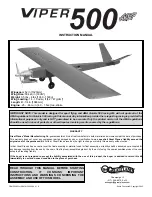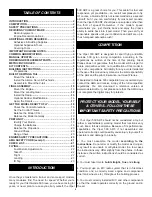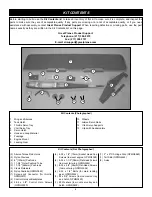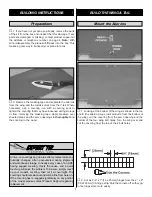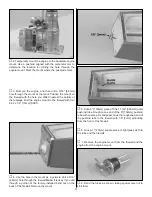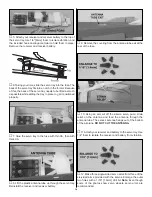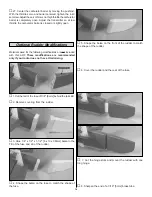
INTRODUCTION ................................................................2
COMPETITION ..................................................................2
SAFETY PRECAUTIONS ..................................................2
DECISIONS YOU MUST MAKE ........................................3
Radio Equipment .........................................................3
Engine Recommendations...........................................3
ADDITIONAL ITEMS REQUIRED .....................................3
Adhesives & Building Supplies ....................................3
Optional Supplies & Tools ............................................4
Covering Tools .............................................................4
IMPORTANT BUILDING NOTES.......................................4
COMMON ABBREVIATIONS ............................................4
MANUAL UPDATES ..........................................................4
ORDERING REPLACEMENT PARTS...............................5
METRIC/INCH RULER ......................................................5
KIT CONTENTS.................................................................6
BUILDING INSTRUCTIONS ..............................................7
Preparations.................................................................7
BUILD THE WING & TAIL..................................................7
Mount the Ailerons.......................................................7
Install the Aileron Servo & Pushrods ...........................8
Assemble & Mount the V-tail........................................9
FINAL ASSEMBLY ..........................................................10
Mount the Engine.......................................................10
Mount the Landing Gear ............................................12
Install the Radio .........................................................13
Optional Rudder Modifications...................................16
Apply the Decals........................................................17
GET THE MODEL READY TO FLY..................................18
Check the Control Directions .....................................18
Set the Control Throws ..............................................18
Balance the Model (C.G.) ..........................................18
Balance the Model Laterally ......................................19
PREFLIGHT .....................................................................19
Identify Your Model.....................................................19
Charge the Batteries..................................................19
Balance the Propellers...............................................20
Ground Check............................................................20
Range Check .............................................................20
ENGINE SAFETY PRECAUTIONS .................................20
AMA SAFETY CODE (excerpt) ......................................21
CHECK LIST....................................................................21
FLYING.............................................................................22
Fuel Mixture Adjustments ..........................................22
Takeoff .......................................................................22
Flight ..........................................................................22
Landing ......................................................................23
ID Tag.........................................................................23
Once they’ve mastered a trainer and some sport models,
many modelers find “the need for speed.” Whether you’re
ready for your first Quickie 500 race, you’ve been racing for
years, or never plan to race anyone but yourself, the Viper
500 ARF is a great choice for you. This aircraft is fast and
responsive, yet predictable – an overall real pleasure to fly.
Of course, a Quickie 500 is not recommended as a second
aircraft, but if you can comfortably fly most sport models,
then the Viper 500 ARF should pose no surprises other than
the thrill of speed! Remember, if the model’s speed
overwhelms you, just throttle back and enjoy the Viper’s
ability to settle back into “sport mode.” Then you can fly at
reasonable speeds until your confidence and skill are up to
their full-speed adrenaline rush!
The Viper 500 ARF is designed for sport flying and AMA
Quickie 500 pylon racing competition according to the
regulations as written at the time of this printing. Great
Planes does not guarantee that the model will be legal for
future competitive events, nor qualification of this model in
any such competitions. All liability for any events incidental
to the use of this model in any manner is the sole responsibility
of the pilot and the pilot’s insurance, not Great Planes.
If interested in Quickie 500 competition, we recommend you
contact the AMA and receive a copy of the full competition
regulations. You can download a reference version at
www.modelaircraft.org, but please note that the AMA does
not recognize the digital copy for protests.
1. Your Viper 500 ARF should not be considered a toy, but
rather a sophisticated, working model that functions very
much like a full-size airplane. Because of its performance
capabilities, the Viper 500 ARF, if not assembled and
operated correctly, could possibly cause injury to yourself or
spectators and damage to property.
2. You must assemble the model according to the
instructions. Do not alter or modify the model, as doing so
may result in an unsafe or unflyable model. In a few cases
the instructions may differ slightly from the photos. In those
instances the written instructions should be considered as
correct.
3. You must take time to build straight, true and strong.
4. You must use an R/C radio system that is in first-class
condition, and a correctly sized engine and components
(fuel tank, wheels, etc.) throughout the building process.
5. You must correctly install all R/C and other components
so that the model operates correctly on the ground and in
the air.
PROTECT YOUR MODEL, YOURSELF
& OTHERS...FOLLOW THESE
IMPORTANT SAFETY PRECAUTIONS
COMPETITION
INTRODUCTION
TABLE OF CONTENTS
2

